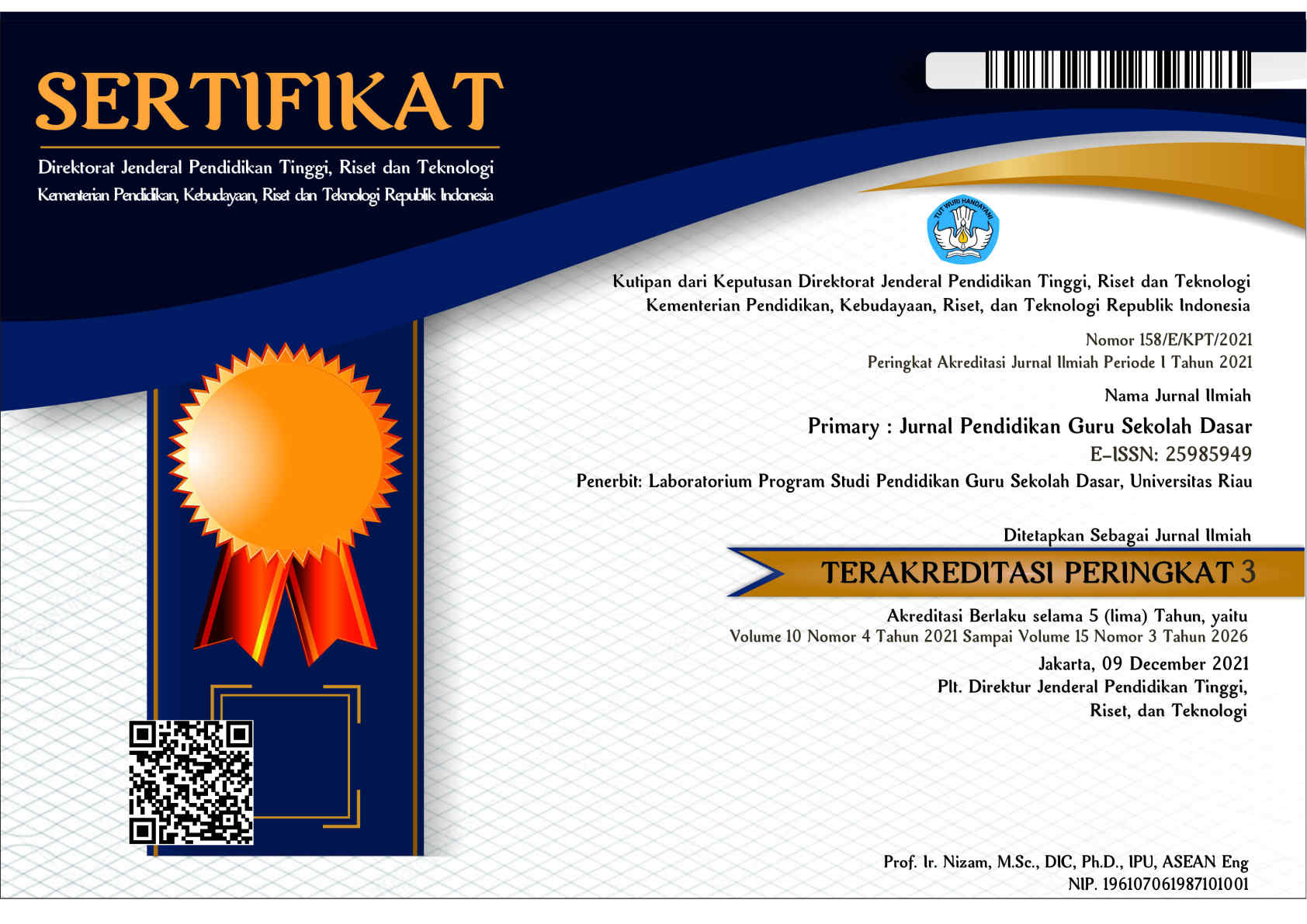IMPLEMENTATION OF CHILD-FRIENDLY SCHOOLS IN DEVELOPING STUDENTS’ CHARACTER
Abstract
Keywords
Full Text:
PDFReferences
Kristanto, K., Khasanah, I., & Karmila, M. (2011). Identifikasi model sekolah ramah anak (sra) jenjang satuan pendidikan anak usia dini se-kecamatan Semarang selatan. Paudia: Jurnal Penelitian Dalam Bidang Pendidikan Anak Usia Dini, 1(1-20).
Aitami, S., Syamsuri, S., & Setiani, Y. (2020). Implementasi Pendidikan Karakter dalam Pembelajaran Matematika. Wilangan: Jurnal Inovasi dan Riset Pendidikan Matematika, 1(1), 53-63.
Fahyuni, E. F., Fauji, I., & Addaa'i, M. N. (2020). Application of Child Friendly Schools Through the Hizbul Wathan Scouting Movement To Form Elementary Student Leadership Character. Halaqa: Islamic Education Journal, 4(1), 1-9.
Arief, A. (2014). Pengembangan pendidikan budaya dan karakter bangsa dalam upaya menghadapi tantangan global. TARBIYA: Journal of Education in Muslim Society, 1(2), 215-226.
Nadhifa, F., Witri, G., & Guslinda, G. (2021). UPAYA PERSONIL SEKOLAH DALAM MEWUJUDKAN SEKOLAH RAMAH ANAK DI SEKOLAH DASAR NEGERI 110 PEKANBARU. Jurnal Ilmiah Aquinas, 4(2), 353-365.
Huda, S., & Istofa, D. N. (2021). Strategi Penyelenggaraan Program Sekolah Ramah Anak: Analisis Peran Kepala Sekolah di SD Tanjung Jabung Timur Jambi. JMiE (Journal of Management in Education), 6(2), 75-82.
Kurniyawan, M. D., Sultoni, S., & Sunandar, A. (2020). MANAJEMEN SEKOLAH RAMAH ANAK. JAMP: Jurnal Administrasi dan Manajemen Pendidikan, 3(2), 192-198.
Yosada, K. R., & Kurniati, A. (2019). Menciptakan sekolah ramah anak. Jurnal Pendidikan Dasar Perkhasa: Jurnal Penelitian Pendidikan Dasar, 5(2), 145-154.
Rangkuti, S. R., & Maksum, I. R. (2019). Implementasi Kebijakan Sekolah Ramah Anak Dalam Mewujudkan Kota Layak Anak di Kota Depok. Publik (Jurnal Ilmu Administrasi), 8(1), 38-52.
Putri, A., & Akmal, A. (2019). Sekolah Ramah Anak: Tantangan dan Implikasinya Terhadap Pemenuhan Hak Anak. Journal of Civic Education, 2(3), 228-235.
Kholiq, S. M. (2018). Rintisan Sekolah Ramah Anak di Sekolah Dasar Negeri Mentel II Gunungkidul. Spektrum Analisis Kebijakan Pendidikan, 7(5), 516-528.
Shodiq, M. (2019). Studi Deskriptif Penyebab Bullying di Sekolah Dasar: Refleksi Implementasi Modulab sebagai Model Sekolah Ramah Anak. Child Education Journal, 1(2), 73-77.
Liftiah, L., Mahanani, F. K., & Amawidyati, S. A. G. (2018). Violence Awareness dan Partisipasi Guru dalam Pengembangan Sekolah Ramah Anak. Intuisi: Jurnal Psikologi Ilmiah, 10(3), 284-292.
Setyawati, V., & Subowo, S. (2018). Pengaruh Motivasi Belajar, Lingkungan Keluarga Dan Peran Guru Terhadap Disiplin Belajar Siswa. Economic Education Analysis Journal, 7(1), 29-44.
Hari Wijaya, P., & Kusumaningtyas, R. (2018). Komunikasi Interpersonal antara Guru Bimbingan Konseling (BK) dengan Siswa dalam Mencegah Perilaku Membolos Pada Siswa SMK Binawiyata Sragen Tahun Ajaran 2017/2018 (Doctoral dissertation, Universitas Muhammadiyah Surakarta).
Nuhamara, D. (2018). Pengutamaan Dimensi Karakter Dalam Pendidikan Agama Kristen. Jurnal Jaffray, 16(1), 93-114.
Kurniawati, I., & Kristianto, R. D. (2018). Pengaruh Kualitas Sumber Daya Manusia, Pemanfaatan Teknologi Informasi dan Sistem Pengendalian Intern Akuntansi terhadap Keterandalan Laporan Keuangan. Jurnal Akuntansi dan Sistem Teknologi Informasi, 14(1-8).
Kristanto, I. K., & Karmila, M. (2011). Identification of child-friendly school model (sra) level of early childhood education unit in Southern Semarang sub-district. PAUDIA Research Journal, 1(1-5).
Baehaki, F., Fadhilah, W. K., & Karmila, M. (2022). Separation of Chromium (VI) Metal in Wastewater Using Electrocoagulation Method with NaCl Coagulant. Stannum: Jurnal Sains dan Terapan Kimia, 4(1), 27-33.
Suratno, S., & Rahmatullah, M. (2020). The evaluation of school friendly children's programs towards banjarmasin as a child friendly city. the evaluation of school friendly children's programs towards banjarmasin as a child friendly city. 3(1-10).
Hasibuan, A. T., Simangunsong, N., Rahmawati, E., & Rahmaini, R. (2020). Humanization of Education in the Challenges and Opportunities of the Disruption Era at Nahdlatul Ulama Elementary School. Al Ibtida: Jurnal Pendidikan Guru MI, 7(2), 264-279.
Jumari, J., & Suwandi, S. (2020). Evaluation of Child-Friendly Schools Program in Islamic Schools using the CIPP Model. Dinamika Ilmu, 323-341.
Amrina, A., Aprison, W., Sesmiarni, Z., Iswantir, M., & Mudinillah, A. (2022). Sekolah Ramah Anak, Tantangan dan Peluangnya dalam Pembentukan Karakter Siswa di Era Globalisasi. Jurnal Obsesi: Jurnal Pendidikan Anak Usia Dini, 6(6), 6803-6812.
Martodiryo, S., & Rahmatullah, M. (2022). The Evaluation of Children Friendly School's Programs towards Banjarmasin as a Children Friendly City. Interdisciplinary Social Studies, 2(3), 1706-1714.
Tusriyanto, T., Anggaira, A. S., Lisdiana, A., Purwasih, A., Karsiwan, K., Wahidah, N. I., ... & Iskandar, I. (2022). The implementation of child-friendly school to fulfill children’s rights and prevent violence against children. Al-Ishlah: Jurnal Pendidikan, 14(2), 2465-2478.
Ansori, Y. Z. (2020). Pembinaan karakter siswa melalui pembelajaran terpadu di sekolah dasar. Jurnal Educatio Fkip Unma, 6(1), 177-186.
Judiani, S. (2010). Implementasi pendidikan karakter di sekolah dasar melalui penguatan pelaksanaan kurikulum. Jurnal pendidikan dan kebudayaan, 16(9), 280-289.
Tardian, A. (2019). Manajemen Strategik Mutu Sekolah. Jurnal kependidikan, 7(2), 192-203.
Rohmah, N., AY, M. H., & Kusmintardjo, K. (2016). Strategi peningkatan kemampuan dosen dalam penulisan karya ilmiah (studi multi kasus pada Unisda dan Staidra di Kabupaten Lamongan). Jurnal Pendidikan: Teori, Penelitian, Dan Pengembangan, 1(7), 1312-1322.
Rangkuti, S. R., & Maksum, I. R. (2019). Analisis Implementasi Kebijakan Sekolah Ramah Anak Di Smp Negeri 6 Depok. JPSI (Journal of Public Sector Innovations), 4(1), 8-19.
Fitriya, S., Hidayat, R., & Rizki, M. F. (2021). Implementasi Kota Layak Anak Melalui Program Sekolah Ramah Anak (SRA) di Kota Bekasi. Jurnal Kajian Ilmiah, 21(4), 377-390.
DOI: http://dx.doi.org/10.33578/jpfkip.v12i1.9413
Refbacks
- There are currently no refbacks.
Copyright (c) 2023 Nana Mulyana

This work is licensed under a Creative Commons Attribution-NonCommercial-ShareAlike 4.0 International License.
____________________________________________________________
Primary: Jurnal Pendidikan Guru Sekolah Dasar
Secretariat
Program Studi Pendidikan Guru Sekolah Dasar
Gedung B1, FKIP Universitas Riau
Kampus Bina Widya Km. 12,5 Simpang Baru Panam
Pekanbaru Riau Indonesia 28293
e-mail : primary@ejournal.unri.ac.id



